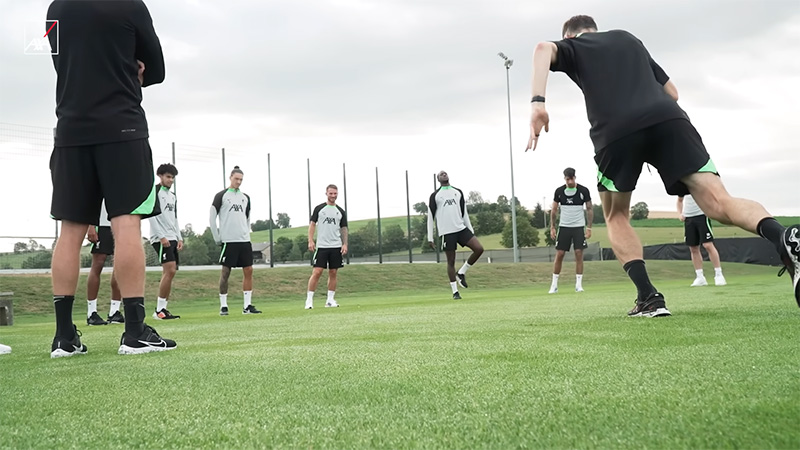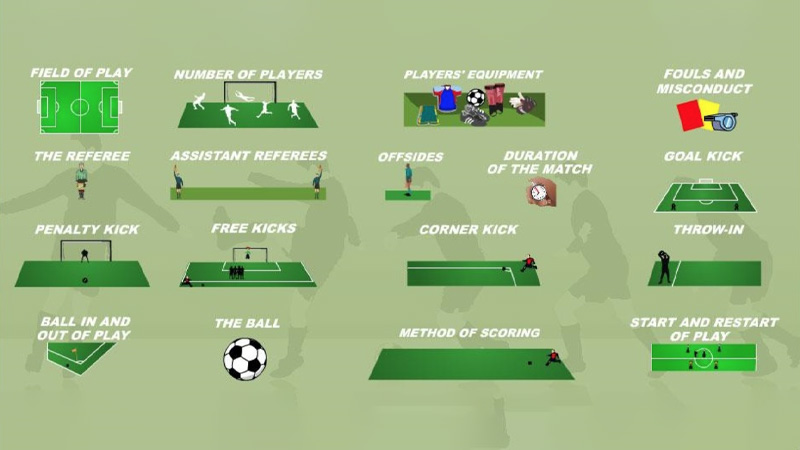If you’ve ever felt the thrill of watching players gracefully navigate the pitch or dreamt of joining the action yourself, this guide is your gateway to learning how to play soccer.
From the basic rules and essential techniques to positioning, dribbling, passing, shooting, and defending, we’ll break down the fundamentals step by step.
Whether you’re a complete beginner or looking to enhance your game, this comprehensive introduction will equip you with the knowledge and confidence to embrace the sport with enthusiasm.
Whether you’re a beginner looking to understand the basics or an aspiring athlete seeking to improve your skills, this comprehensive guide will walk you through the essentials of playing soccer and explore how to play soccer.
So, lace up your cleats, grab a ball, and let’s embark on a journey into the captivating world of soccer. Let the games begin!
How to Play Soccer?
The main goal of soccer is simple – score more goals than the opposing team within the allotted time. Each team comprises eleven players, including a goalkeeper.
Soccer is typically played on a rectangular field, ranging from 100-130 yards long and 50-100 yards wide, depending on the level of play. There are two goals, one at each end, and a halfway line divides the field into two halves.
Familiarize yourself with the basic rules, such as offside, fouls, yellow and red cards, throw-ins, corner kicks, and penalty kicks. A good understanding of these rules will help you play within the boundaries of the game.
Mastering Ball Control
Dribbling is the art of maneuvering the ball with your feet while maintaining control. Use the inside and outside of your foot to dribble and practice changing direction and speed to deceive opponents.
Passing is essential in soccer, and mastering accurate passes can make all the difference in a match. Practice short, long, and chipped passes using both feet to become a versatile player.
Scoring goals is the ultimate thrill in soccer. Develop your shooting technique by striking the ball with the laces for power and the inside of your foot for accuracy. Remember to keep your eyes on the ball and follow through with your shot.
Tactical Awareness
Understand your role on the field and your position’s responsibilities. Whether you’re a defender, midfielder, or forward, knowing where to be at different phases of the game is crucial.
Soccer is a team sport, and effective communication and cooperation are essential. Learn to read your teammates’ movements, pass to open players, and provide support when your team is in possession.
Defenders play a crucial role in protecting the goal. Learn how to jockey, tackle, and intercept passes to thwart the opposition’s attacks.
Physical Fitness and Conditioning
Soccer is a demanding sport that requires players to cover substantial distances during a game. Build your endurance through regular cardiovascular exercises such as running or cycling.
Develop overall body strength to enhance your performance in challenges, shielding the ball, and striking powerful shots. Improve your agility and balance to make quick turns, change directions, and evade opponents.
Mental Aspects
Soccer requires mental concentration and quick decision-making. Stay focused throughout the match to capitalize on opportunities and adapt to changing circumstances.
Believe in your abilities and have confidence in your skills. A positive mindset can elevate your performance on the field.
How Can I Learn Soccer Easily?

Learning soccer can be an enjoyable and rewarding experience, even if you are starting as a beginner. Here are some practical steps to help you learn soccer easily:
Start with the Basics
Begin by familiarizing yourself with the fundamental rules, positions, and objectives of the game. Watch professional matches and observe how players move on the field, pass, shoot, and defend. Understanding the game’s structure will provide a solid foundation for your learning journey.
Practice Ball Control
The ability to control the ball is essential in soccer. Practice dribbling the ball using both feet, passing to a target, and receiving passes from others. Spend time honing your ball control skills, and gradually increase the difficulty as you gain confidence.
Join a Soccer Program or Team
Consider joining a local soccer program or team. Participating in organized training sessions and matches with experienced coaches and teammates can accelerate your learning process. Interacting with others who share the same passion for the sport can be motivating and fun.
Watch and Learn
Continue watching professional soccer games, paying attention to the movements, techniques, and strategies employed by top players. Observe how they position themselves, make decisions, and handle different game situations. Analyzing the pros can inspire you to improve your own skills.
Practice Regularly
Consistency is key to improving in any sport. Set aside regular practice sessions, even if they are short, to work on your soccer skills. Regular practice will help you build muscle memory and improve your overall game.
Improve Fitness and Conditioning
Soccer demands physical fitness, so focus on building endurance, strength, and agility. Engage in cardiovascular exercises, strength training, and flexibility exercises to enhance your performance on the field.
Play with Others
Whenever possible, play soccer with friends, family, or colleagues. Playing with others can help you understand teamwork, communication, and game dynamics in a practical setting. It also adds a fun and social element to your soccer learning journey.
Basic Soccer Rules

Source: soccer-training-methods
Soccer, also known as football in many parts of the world, has a set of basic rules that govern the game. Here are some of the fundamental soccer rules:
The Objective
The primary objective of soccer is to score goals. Each team aims to kick the ball into the opposing team’s goal while preventing the other team from doing the same.
Teams and Players
A soccer team consists of eleven players, including one goalkeeper. The positions include defenders, midfielders, and forwards. Teams can make substitutions during the game, but the number of substitutions may vary depending on the competition rules.
Duration of the Game
A standard soccer match consists of two halves, each lasting 45 minutes, with a 15-minute halftime break. Therefore, the total duration of a regular soccer game is 90 minutes.
Offside Rule
A player is considered offside if they are in the opposing team’s half of the field and ahead of both the ball and the second-last defender (usually the last outfield player) at the moment when the ball is played to them.
Fouls
Soccer has rules to discourage dangerous play and ensure fair competition. Common fouls include tripping, pushing, holding, kicking, or making contact with an opponent’s hand (except for the goalkeeper within their penalty area).
Penalty Kicks
A penalty kick is awarded when a foul is committed by a defending player inside their own penalty area. The attacking team takes the penalty kick from a designated spot, usually 12 yards (11 meters) away from the goal.
Yellow and Red Cards
Referees use yellow and red cards to discipline players for misconduct. A yellow card is a caution, shown for unsporting behavior or persistent fouling. Two yellow cards in a single match result in a red card, leading to the player’s expulsion from the game.
Throw-Ins
When the ball crosses the touchline (sideline), the opposing team is awarded a throw-in. The player taking the throw-in must use both hands while keeping both feet on or behind the touchline.
How to Play Different Positions?
Playing different positions in soccer requires understanding the specific roles and responsibilities associated with each position. Here’s a guide on how to play some of the common positions in soccer:
Goalkeeper
Positioning:
As a goalkeeper, positioning is crucial. Stay alert and position yourself between the goalposts to block shots effectively.
Shot Stopping:
Master the art of shot-stopping by using proper hand and body positioning to save shots from various angles and distances.
Handling:
Work on catching and holding the ball securely to prevent rebounds and give your team control.
Distribution:
Improve your distribution by throwing or kicking the ball accurately to start counter-attacks or build-up play.
Defenders (Center-backs and Full-backs)
- Marking: Learn how to mark opposing attackers closely to prevent them from receiving the ball comfortably.
- Tackling: Develop strong tackling skills to win the ball back from opponents cleanly and efficiently.
- Clearances: Practice making timely clearances to remove the ball from dangerous areas near your goal.
- Overlapping (for Full-backs): Full-backs should practice overlapping runs to provide attacking options and deliver crosses into the box.
Midfielders (Defensive, Central, and Attacking)
- Passing: Master short and long passing techniques to maintain possession and distribute the ball effectively.
- Vision: Develop a good vision to spot opportunities for through passes or switching play.
- Defensive Duties (for Defensive Midfielders): Defensive midfielders should focus on breaking up the opponent’s attacks and shielding the defense.
- Creativity (for Attacking Midfielders): Attacking midfielders need to be creative, providing key passes and supporting forwards in the attacking third.
Forwards (Strikers and Wingers)
Finishing: Work on your shooting accuracy and power to capitalize on scoring opportunities.
Movement: Learn to make intelligent runs to create space and exploit the opposition’s defense.
Crossing (for Wingers): Wingers should practice delivering accurate crosses into the box to assist strikers.
FAQs
What is the duration of a standard soccer match?
A standard soccer match consists of two halves, each lasting 45 minutes, with a 15-minute halftime break. Therefore, the total duration of a regular soccer game is 90 minutes.
What is the offside rule in soccer?
The offside rule is a fundamental aspect of soccer that regulates the positioning of attacking players during an offensive play. A player is considered offside if they are in the opposing team’s half of the field and ahead of both the ball and the second-last defender (usually the last outfield player) at the moment when the ball is played to them.
How do penalty shootouts work?
In knockout competitions or decisive matches where a winner must be determined if the game ends in a draw after regular time and any additional time, a penalty shootout is used to determine the winner. Each team selects five players to take turns shooting penalties against the opposing goalkeeper.
Can goalkeepers score goals in soccer?
Yes, goalkeepers can score goals in soccer, but it is a relatively rare occurrence. A goalkeeper can score by taking a shot from their own penalty area and sending the ball into the opposing team’s net. To do so, the ball must be in play when the shot is taken, meaning it cannot be directly scored from a goal kick.
What are the yellow and red cards used for in soccer?
Yellow and red cards are used by referees to discipline players for various offenses on the field. A yellow card is a cautionary card, shown to a player as a warning for unsporting behavior, persistent fouling, or other minor offenses.
Two yellow cards in a single match result in a red card, which means the player is sent off, and their team must play with ten players for the remainder of the game.
Bottom Line
Congratulations, now you know how to play soccer! As you’ve learned, soccer is more than just a game; it’s a celebration of passion, dedication, and camaraderie.
By mastering the essential skills and understanding the intricacies of the sport, you’re now equipped to enjoy and contribute to the beautiful game.
Remember, soccer is a continuous learning experience, and every match presents an opportunity to grow and improve.
As you practice and play, cherish the friendships formed on the pitch and the exhilaration of scoring a goal or executing a perfect pass.
Whether you aspire to join a competitive team, play with friends for fun, or simply enjoy watching matches as a fan, your newfound knowledge of soccer will enrich your experience.
Now, go forth with confidence, and embrace the joy of soccer. May your journey be filled with unforgettable moments and a lifelong love for the sport.
The world of soccer awaits, so let your passion for the game guide you to countless victories and memories on and off the field. Good luck and enjoy the game!







